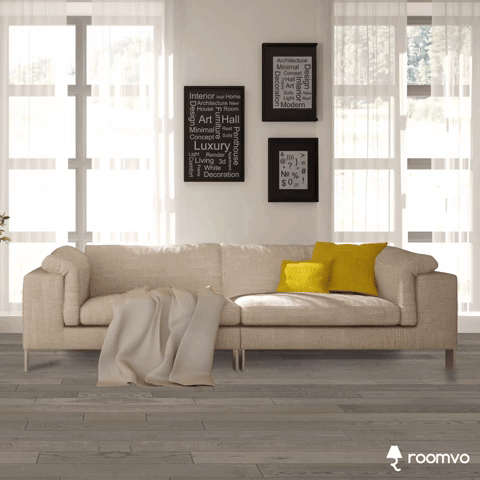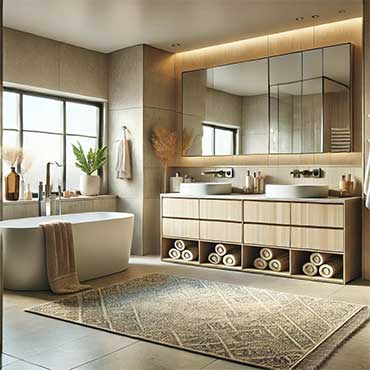
Using Sheet water-resistant in the Bathroom: A Designer’s Perspective
Introduction to Bathroom Flooring with Sheet Vinyl
For interior designers and decorators, the bathroom is more than a space of function; it’s a room for expression, comfort, and utility. Every aspect, from layout to material choice, contributes to creating a cohesive, relaxing, and practical environment. When selecting bathroom flooring, resilience to moisture, comfort underfoot, and harmony with the bathroom’s aesthetic are essential factors. Sheet Vinyl Flooring offers an enticing option, promising versatility, durability, and style to meet both functional and aesthetic demands. However, does it truly align with the needs of a high-traffic, moisture-prone bathroom environment?
Sheet Vinyl Flooring, with its ability to mimic the look of stone, hardwood, or tiles, has evolved into a high-end product that caters to modern design sensibilities. Thanks to advanced printing technology and a cushioned construction, it brings together visual appeal and durability, making it particularly suitable for bathrooms. In this post, we’ll explore the specific qualities of Sheet Vinyl Flooring, examining how it can support designers in creating cohesive, elegant, and long-lasting bathroom spaces.
Pros and Cons of Using Sheet Vinyl Flooring in the Bathroom
Pros:
- Water Resistance: Sheet Vinyl Flooring’s seamless surface ensures excellent water resistance, an essential feature for any bathroom.
- Comfort Underfoot: The cushioned layers of vinyl make it comfortable to walk on, especially appreciated in a space often navigated barefoot.
- Ease of Maintenance: Unlike grout in tile, which requires frequent cleaning, vinyl offers a simple wipe-clean surface, saving time and maintenance efforts.
- Cost Efficiency: Vinyl provides a more affordable alternative to natural stone or ceramic, making it accessible without compromising style.
- Aesthetic Variety: From natural stone to wood visuals, vinyl offers diverse design options, allowing designers to customize the bathroom’s look.
Cons:
- Potential Fading: While durable, some vinyl can fade over time if exposed to intense sunlight. Bathrooms with large windows may require UV-protective treatments.
- Limited Resale Appeal: High-end buyers may favor natural materials over vinyl, which could impact the perceived value of the space.
- Eco-Friendliness Concerns: Although vinyl’s durability is a plus, it is a synthetic product, which may not align with eco-conscious design preferences.
Key Design Considerations
1. Room Purpose
Bathrooms are high-moisture environments that require materials resistant to water damage. Sheet Vinyl Flooring’s waterproof nature makes it ideal for bathrooms, where moisture can compromise wood and other porous materials. Its seamless installation prevents water from seeping through, ensuring longevity and ease of care.
2. Design Style
Sheet Vinyl Flooring offers versatility to accommodate any style, from modern to rustic. Designers can select vinyl patterns that replicate marble for an upscale feel or wood grain for a warmer aesthetic. This adaptability allows it to seamlessly blend with a wide range of design motifs, supporting the cohesive flow that decorators strive for.
3. Durability
In high-traffic spaces like bathrooms, durability is key. The protective wear layer on Sheet Vinyl Flooring guards against scratches and dents, making it suitable for everyday wear and tear. This ensures that the flooring maintains its pristine appearance, an essential consideration for maintaining a luxury bathroom look.
4. Moisture Exposure
Bathroom flooring must withstand humidity and spills. Sheet Vinyl is inherently water-resistant, protecting against moisture damage and ensuring that it remains unaffected by steam or standing water. This feature alone makes it a preferred choice over options like hardwood, which can warp in similar conditions.
5. Budget
Sheet Vinyl Flooring offers a balance between quality and cost, making it suitable for budget-conscious projects. It provides the aesthetic appeal of high-end materials like marble or hardwood at a fraction of the price, enabling designers to achieve an upscale look without exceeding project budgets.
6. Subfloor Condition
Vinyl is forgiving on various subfloor types, often requiring minimal preparation. This makes it a practical choice for older homes or quick remodels where subfloor adjustments might be costly or time-consuming. A smooth subfloor, however, is essential to prevent imperfections from showing on the surface.
7. Eco-Friendliness
Vinyl’s synthetic composition may be a drawback for eco-conscious clients, as it’s less sustainable than natural options. However, many brands now offer low-VOC options, improving air quality and reducing environmental impact. For clients prioritizing green design, opting for these greener vinyl alternatives can be a suitable compromise.
8. Soundproofing and Insulation
Bathrooms benefit from sound-dampening materials, especially in multi-level homes or apartments. Sheet Vinyl Flooring’s cushioned backing provides moderate insulation, reducing noise and offering a more pleasant experience. This acoustic benefit can enhance the bathroom’s overall ambiance, promoting a sense of calm.
9. Health Considerations
Bathrooms require hygienic materials that can withstand frequent cleaning. Vinyl’s smooth surface resists mold, mildew, and bacteria growth, contributing to a healthier space. For clients who prioritize a low-maintenance, germ-resistant environment, vinyl is a smart and hygienic flooring choice.
Impact on Design Elements
Color Scheme and Visual Appeal
Sheet Vinyl Flooring can complement or contrast a bathroom’s color scheme, enhancing the room's visual depth. Neutral-toned vinyl can provide a minimalist base, while patterned options can add drama and elegance, supporting diverse design visions.
Style and Theme Coherence
Vinyl’s ability to mimic high-end materials allows it to seamlessly integrate with any decor theme, from sleek contemporary to classic rustic. Designers can achieve a consistent aesthetic without sacrificing functionality.
Texture and Feel
The soft underfoot texture of vinyl makes it a comfortable and safe choice for bathrooms, especially compared to ceramic or stone. Its cushioned feel contributes to a spa-like atmosphere, enhancing the bathroom’s relaxation potential.
Room Size Perception
Lighter-colored vinyl can make smaller bathrooms feel more spacious, while darker hues create a cozy ambiance. This flexibility allows designers to use flooring to subtly adjust the room's spatial perception.
Comfort and Usability
Vinyl’s resilient surface remains comfortable underfoot, reducing the cold, hard feel often associated with bathroom flooring. This usability factor aligns with clients’ desires for functional, user-friendly bathroom spaces.
Acoustic Impact
The cushioned structure of vinyl absorbs sound, reducing echo in a tiled bathroom. This can enhance privacy and create a quieter, more serene bathroom experience.
Pattern and Focal Points
Designers can use vinyl patterns to create visual interest or direct attention to specific areas, such as the vanity. Subtle textures allow other elements like bold wall tiles or decorative fixtures to remain focal points, while patterned vinyl adds depth and complexity.
Final Thoughts
Sheet Vinyl Flooring is a versatile and practical option for bathrooms, balancing aesthetic potential with durability and moisture resistance. It caters to designers who value innovation, providing a high-quality alternative to natural materials without sacrificing style or functionality. While vinyl may lack the prestige of stone or ceramic, its advancements in design and resilience have made it an appealing choice for modern bathrooms.
Ultimately, the decision to use Sheet Vinyl Flooring in a bathroom depends on the project’s priorities and client preferences. For spaces requiring cost-effective elegance, easy maintenance, and high moisture resistance, vinyl stands out as an exceptional choice. Its flexibility in design, comfort, and durability makes it a reliable foundation for creating beautiful, practical bathroom interiors.
Choose Flooring Product : Area Rugs Ideas (2) : Ceramic/Porcelain Ideas (57) : Wood Flooring Ideas (9) : Laminate Flooring Ideas (3) : Vinyl/Resilient Ideas (5) : LVT/LVP Ideas (22) : Ceramic/Porcelain Ideas (57)

roomvo
Visualize Flooring In Your Bathroom!
Roomvo makes picking new floors easy. Take advantage of our room visualizer tool to see what your home will look like with any flooring products from our catalog. Just upload your photo to see your room come to life.
 Blog
BlogBathroom - Area Rugs
Elevate Bathroom Style with Area Rugs: Pros, Cons, and Design Insights
This article, crafted by Arabella Whitethorn, explores the use of bathrooms in bathrooms, discussing both their decorative potential and practical considerations. Designed for interior designers and decorators, it addresses nine critical design factors, from moisture resistance to style cohesion, helping readers understand when and how to incorporate area rugs in a bathroom setting. Whether enhancing acoustic impact or providing a focal point, area rugs can add elegance and warmth, making the bathroom a true sanctuary.
Learn More Blog
BlogBathroom - Art Deco
Transform Your Bathroom with Art Deco Flooring Elegance
Transforming a bathroom into an Art Deco-inspired haven requires careful attention to detail, with flooring serving as a foundational element in both functionality and design. This blog post by Arabella Whitethorn dives into the unique requirements of bathroom flooring, emphasizing how materials like durability and offer the perfect balance of durability, water resistance, and aesthetic appeal. Through a professional yet inspiring lens, the article explores how bold geometric patterns, polished finishes, and rich color palettes can align with the opulent, glamorous style of Art Deco interiors.
Addressing key considerations such as moisture exposure, budget, eco-friendliness, and design coherence, the post provides actionable insights tailored for interior designers and decorators. Whether working on a high-end renovation or a more modest project, this guide equips design professionals with the knowledge to select flooring that not only enhances the visual impact of a bathroom but also ensures practicality and longevity. With thoughtful advice and creative inspiration, the article helps readers create a sophisticated, functional retreat that captures the timeless allure of Art Deco design.
Learn More Blog
BlogBathroom - Carpeting
The Pros and Cons of Using Carpet in the Bathroom: A Designer's Guide
This blog post explores the pros and cons of using in bathroom designs, a choice that can add warmth and a unique aesthetic but also presents practical challenges. Aimed at interior designers and decorators, it delves into considerations like moisture resistance, durability, and maintenance, essential factors when choosing the right flooring for high-moisture environments. The article also addresses how carpeting impacts the bathroom's color scheme, style coherence, and acoustic quality, helping designers visualize how carpet could align with the room’s purpose and ambiance. With insights on suitable carpet materials and installation tips, this guide provides a comprehensive look at how to incorporate carpet in bathroom spaces while balancing style with functionality.
Learn More Blog
BlogBathroom - Ceramic Tile
Why Interior Designers Choose Ceramic Tile for Luxurious Bathroom Designs
In this post, interior designer Arabella Whitethorn delves into the benefits of using in bathroom spaces, focusing on its aesthetic versatility, durability, and eco-friendliness. Written for interior designers and decorators, the article addresses how ceramic tile aligns with both the functional and stylistic demands of bathroom design. Each design consideration is thoroughly explored to help professionals decide if ceramic tile is the right choice for their bathroom projects, offering insights into color schemes, texture, and overall room ambiance.
Learn More




